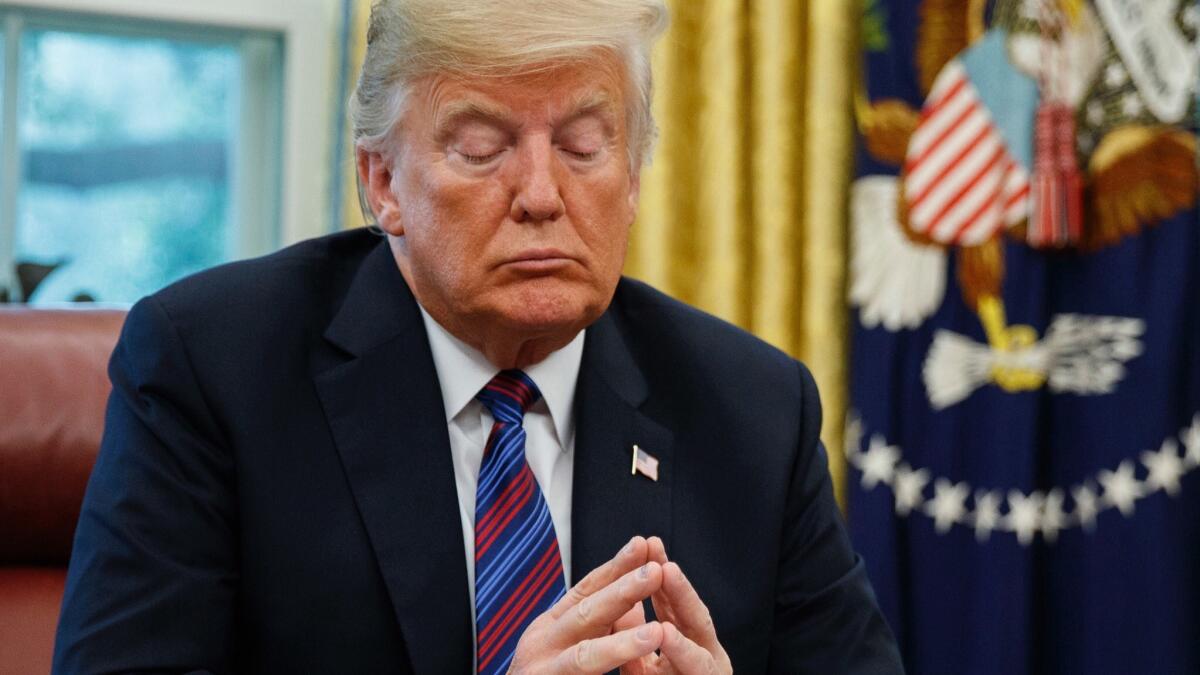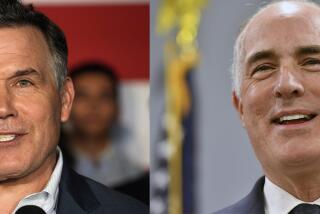Column: Trump’s pay freeze for federal workers may be his most cynical and self-destructive stunt yet

Late Thursday, as I pondered weak and weary the results of a full day’s work, my Twitter feed suddenly became inundated with tweets all more or less on the following theme:
The name was new to me, but after a few moments searching online all became clear. Barbara Comstock is the Republican member of Congress representing a suburban Virginia district adjacent to Washington, D.C. And the leader of her party, President Trump, had just announced he was canceling pay raises for federal civilian employees due to kick in on Jan. 1. The bottom line is an effective pay cut for potentially thousands of Comstock’s constituents.
One almost has to admire Trump for his sheer crassness in making this announcement. He did so just days after he crowed in a tweet that the “economy has never been better.” Yet he cited a law allowing him to cancel the raises in times of “national emergency or serious economic conditions.” And he acted only two days before the start of Labor Day weekend.
We must maintain efforts to put our Nation on a fiscally sustainable course, and Federal agency budgets cannot sustain such increases.
— President Trump
The ghost of Grover Cleveland, who made Labor Day a federal holiday as a sop to workers after National Guardsmen fired into a crowd of railroad strikers in Chicago, killing 30, must be rolling its eyes. (But Cleveland was a Democrat.)
Let’s unpack the numbers and background related to this announcement.
The announcement covers federal civilian workers who were due an automatic cost-of-living increase of 2.1% on Jan. 1. That didn’t even match the rate of annual inflation, which was 2.9%. Nevertheless, Trump is cutting it to zero, which means he’s delivering to federal workers an effective wage reduction of nearly 3%.
The number of employees affected by Trump’s action is a little unclear. Most commentaries late Thursday put the figure at 1.9 million, which means it must exclude postal workers, who number about 600,000. We’ll do the calculations both ways.
If the announcement covers all workers, then it affects wages totaling $237.3 billion this year. (Benefits add $99.9 billion more, but they aren’t affected.) If it’s non-postal workers only, then the total 2018 bill is $201.6 billion.
Apply 2.1% to those figures, and the cost-of-living adjustment for 2019 would cost the budget about $5 billion; non-postal employees only, and it would be $4.2 billion.
“We must maintain efforts to put our Nation on a fiscally sustainable course, and Federal agency budgets cannot sustain such increases,” Trump wrote.
For comparison’s sake, the tax cut enacted by congressional Republicans and signed by Trump in December is estimated to cost more than $1.5 trillion over 10 years. That’s $150 billion per year. If you’re keeping track, the tax cut will cost 30 times as much as the pay raise.
Did you hear Trump grouse that the tax cut was coming at a time of “national emergency” and therefore should be zeroed out? Me neither.
This wouldn’t be the first pay freeze imposed on federal workers in recent years. President Obama limited worker pay increases in 2010 and froze federal worker pay in 2011. But those were in times of economic stringency. Trump is imposing the freeze to deal with a budget stringency he created himself. One wonders whether he’s sensitive to the irony that, while he boasts about economic growth, he’s also saying that the only area of the U.S. economy that’s flat on its back is the area under his direct control — federal spending and pay.
A couple of other aspects of Trump’s announcement stand out. One is the disdain for federal workers dripping from every word. He says canceling the COLA “will not materially affect our ability to attract and retain a well‑qualified Federal workforce.” That alone implies that he thinks the workforce already may be overpaid, so zeroing out the COLA won’t hurt.
Trump has shown his opinion of federal workers in other ways, notably the executive orders he signed in May interfering with federal union officials’ ability to deal with contract and grievance issues, making it easier to fire federal workers, and secretly establishing new standards for collective bargaining with federal worker unions. It’s proper to note that all three orders were overturned by a federal judge a week ago.
Trump’s disdain is probably shared by his base, which attends his rallies to bray anti-government shibboleths and probably loves to caricature federal workers as lazy, overpaid slobs. But of course these workers are people like you and me. They’re teachers, drivers, librarians, builders, pavers, engineers, engaged in jobs that include helping average citizens and making sure that you’re not asphyxiated by air pollution, poisoned by water pollution or ripped off by your bank — when they’re not interfered with by Trump’s minions, that is.
As is usual with Trump statements, the pay announcement has its murky spots. What’s unclear, for instance, is how Trump understands the government’s “locality pay” rules. In his announcement, he says he’s canceling “locality pay increases averaging 25.70 percent, costing $25 billion.”
The locality pay system is complicated — it’s designed to bring federal wages into line with non-governmental wages in each affected locality. Locality pay each year is set by a government panel, but it’s not increased each year on the scale that Trump seems to indicate — in other words, federal pay wasn’t set to rise by an additional 25.7% next year on top of the 2.1% COLA.
Each year’s locality pay adjustment replaces the one in effect the year before, so the year-by-year increases tend to be closer to perhaps a few percentage points or less. Whether Trump miscalculated, deliberately misstated the increase, or in fact got it right is something that no doubt will become clearer over time, though probably without the assistance of the White House.
Whether Trump can make his pay cut stick is an open question. His announcement came in the form of a letter to House Speaker Paul Ryan, R-Wisc., and Senate President Pro Tempore Orrin Hatch, R-Utah, in which he proposed “an alternative plan for pay adjustments” effective next Jan. 1. Under the law, the 2.1% raise would take effect unless Trump and Congress change it. But Congress is currently considering a plan to replace that raise with a 1.9% increase.
As for Comstock, farewells may well be in order. Comstock hastened to announce Thursday that she “strongly” opposes eliminating the pay raise. But otherwise she has been a sedulous supporter of Trump, and her seat is in trouble. The Cook Political Report ranks it as leaning Democratic for November. Bye-bye, Barbara?
Keep up to date with Michael Hiltzik. Follow @hiltzikm on Twitter, see his Facebook page, or email michael.hiltzik@latimes.com.
Return to Michael Hiltzik’s blog.
More to Read
Get the L.A. Times Politics newsletter
Deeply reported insights into legislation, politics and policy from Sacramento, Washington and beyond. In your inbox three times per week.
You may occasionally receive promotional content from the Los Angeles Times.







